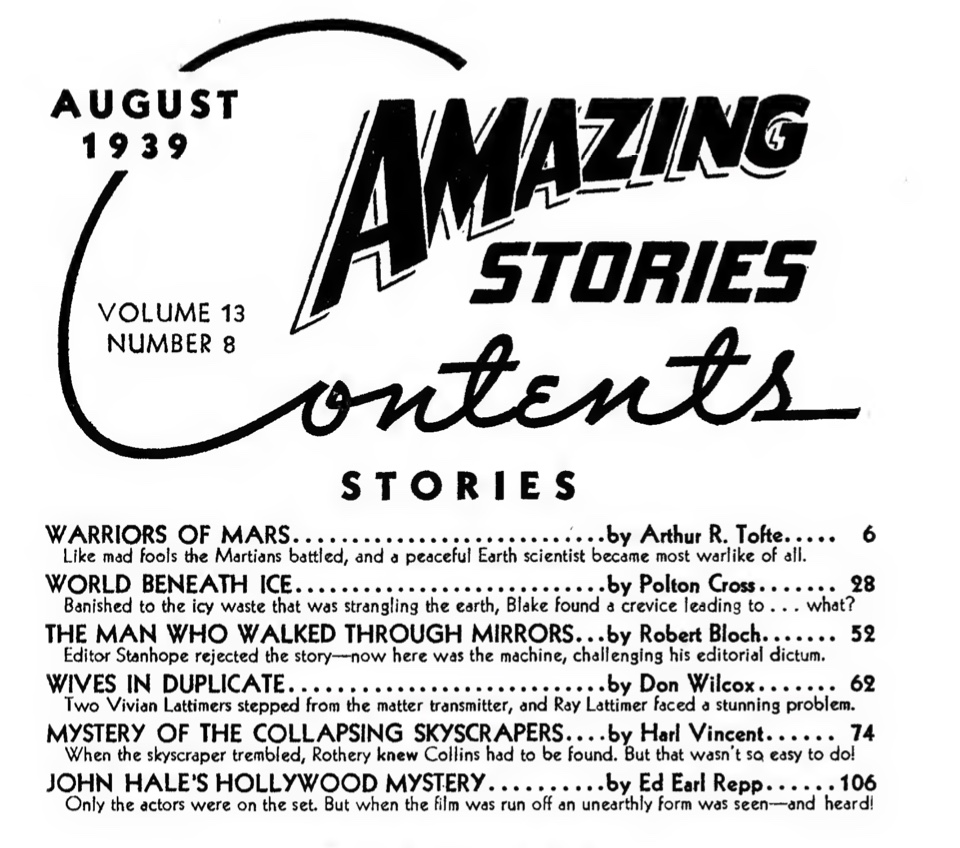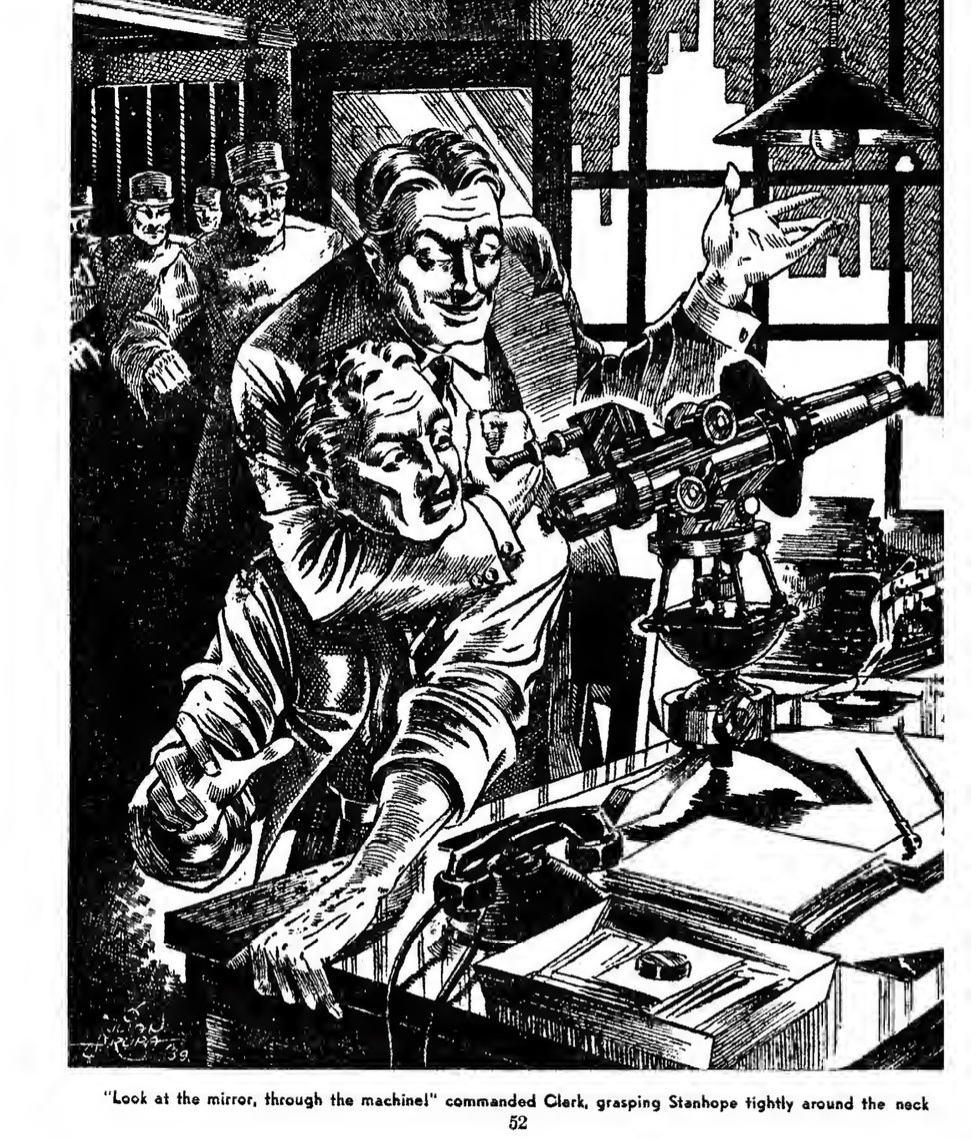| Contributed by
Vijay Fafat
A tongue-in-cheek story making repeated fun of the common, misleading tagline which appeared in many sci fi magazines of the day, “Every Story Scientifically Accurate”.
Volmar Clark was a crackpot genius who had a theory about achieving access to the fourth spatial dimension through mirrors (since, “mirror images are fourth dimensional projections of three dimensional objects”) but had been rejected outright by the science community. Inexplicably, he had then written a story employing those principles, called “Fourth Dimensional Mirror”, and sent to Stanhope, the editor of a sci-fi magazine, who rejected it as being hopelessly inaccurate, scientifically speaking. So a year later, a crazed Volmar entered Stanhope’s office with an apparatus he had built and demanded that Stanhope experience the fourth dimension by looking through its eye-piece, having explained how the device worked.
Stanhope did not believe any of it but after Volmar was carried away by security from the sanitarium from which Volmar had escaped, Stanhope peeked through the eyepiece of the apparatus....
When he came back to his senses from his dizzying experience, he thought it was just a hypnotic, psychedelic experience induced by dizzying, spinning lenses and mirors... till he tried to read and found everything mirror-imaged, including the line, “Every Story Scientifically Accurate”, the implication being that his visual sensations had been flipped through the fourth dimension.
Based on the author’s description, it appears to me that only the brain perceptions of Stanhope would have undergone a mirror-flip, not the rest of his body. Would have been a nice touch to speak of that but the author was aiming mainly at making fun of the tagline and the general tenor of sci fi stories being published then.
|
By my reckoning, this story is only barely mathematical fiction. According to the story's logic, what we see in a mirror is not just reflected light but a glimpse of "another dimension" where things are reversed, but which exists as much as our own. The device has the effect of moving a person's consciousness from the body on one side of the glass into the body on the other. So, when the editor sees the reverse writing, it is an indication that his mind now exists in the body on the other side of the mirror gateway. This notion of "dimension" is not the one from geometry -- which measures the number of independent vectors in a basis of the tangent space -- but just a loose notion of "some other place". In particular, the reversal should not be confused with the idea of taking an n-dimensional object in a higher-dimensional space, moving it and putting it back into the original location but now with its sides reversed (as one can do with a rectangle piece of paper on a tabletop).
As Vijay points out, the irony of the magazine's motto is really the main point of the story, but it still does try to justify this idea of a mirror universe. It does so by referring to the unusual properties of glass (which is interesting, but not mathematics) which can be "properly handled according to mathematical formulae". Despite my insistence in the previous paragraph that it is using "dimension" in a non-mathematical way, it also does try to link it to the four-dimensionality of Minkowski spacetime ("What Einstein and DeSitter hinted at, I shall reveal.")
For me, though, the part which most justifies the inclusion of this story in my database of mathematical fiction is its suggestion that the existence of this mirror universe is something that mathematician Charles Dodgson knew about before writing his Alice adventures:
| (quoted from The Man Who Walked Through Mirrors)
"Clark, be sensible. send me through the mirror? Why that's childish fairy-tale stuff. Like Lewis Carroll's Through the Looking-Glass."
"Exactly," Clark answered, a smile on his pale face. "That's where I got the idea. Oh, you needn't scowl so. Lewis Carroll -- what do you know about the man? He was a mathematician, writing children's books under a pseudonym. Nobody ever noticed the quiet little fellow in real life, yet Alice in Wonderland and Through the Looking Glass are perhaps the most unique literature ever written in themselves. Not only children but adults have found keen satire in their pages; and more than that, the two books are still conceded to be the most accurate descriptions of dreams ever recorded. Do you understand what I mean? Lewis Carroll, the shy, furtive little school-teacher, was one of the world's greatest psychologists. And mark you, he was a mathematician was well. He was no fool -- and when he sent Alice through the mirror into the dream-world he was basing fantasy on the most advanced and abstruse mathematical logic ever conceived. Even today there are those who link dreams with the Fourth Dimension; the mathematical symbols of each are interchangeable. Where but in dreams, or the Fourth Dimension is body and consciousness altered? Where does life take on new and varied forms of expression? I wouldn't be such a fool if I were you."
|
(Note that Robert Bloch also utilizes Lewis Carroll in All on a Golden Afternoon.)
This story was published in the August 1939 issue of Amazing Stories:

 PS Although the story ends with the editor's consciousness seemingly trapped in his mirror-image, this is a problem he can easily remedy. Presumably, he has a mirror-image copy of Clark's device on his mirror-image desk. He can just use it to look back at his body through the glass and return his mind to its original location.
PS Although the story ends with the editor's consciousness seemingly trapped in his mirror-image, this is a problem he can easily remedy. Presumably, he has a mirror-image copy of Clark's device on his mirror-image desk. He can just use it to look back at his body through the glass and return his mind to its original location. |



